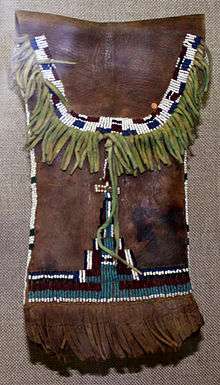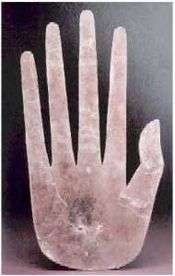Martha Berry (artist)
| Martha Berry | |
|---|---|
 Berry at the Cherokee Art Market in Catoosa, Oklahoma. | |
| Born | Oklahoma, United States |
| Nationality | Cherokee |
| Education | Family, self-taught |
| Known for | Beadwork |
| Movement | Traditional |
| Website | http://www.berrybeadwork.com/ |
| Elected | 1999 Delegate Cherokee Nation Constitution Convention |
Martha Berry is a Cherokee beadwork artist, who has been highly influential in reviving traditional Cherokee and Southeastern beadwork, particularly techniques from the pre-Removal period. She has been recognized as a Cherokee National Treasure.[1][2] Her work is shown in museums around the United States.[3]
Background
Martha Berry was born and raised in Tulsa, Oklahoma.[4] She is a registered tribal citizen of the Cherokee Nation.[4] Berry's grandmother and mother taught her how to sew and embroider at age five.[4] She made her own clothes by age nine. When she was 20, she became a professional seamstress.[4] She has expanded her skills by developing elaborate beadwork art. She taught herself the lost art of Cherokee beadwork by studying photographs of artifacts and examining Cherokee beaded artifacts at the Smithsonian Institution.[5][6]
Artwork
Berry creates beaded bandolier bags, moccasins, belts, knee bands, purses and sashes. She often uses beadwork designs that evolved from pre-Contact Mississippian pottery into traditional 18th and 19th century Southeastern beadwork.[3][7] Berry discovered a unique stitch only used on Southeastern sashes. She is credited with reviving the art of Cherokee beadwork, which had been in serious decline for many years.[3] Her art, expressed through utilitarian items, demonstrates themes such as duality and change throughout life.[8] Berry's beadwork also expresses "current day feelings of conflict, loss, distortion and confusion."[8]
She has won prizes for her beadwork at the Cherokee Art Market, the Five Civilized Tribes Museum, the Heard Museum, and the Cherokee Heritage Center. Berry has delivered lectures on the revival of pre-Contact Cherokee beadwork at the National Liberty Museum in Philadelphia; the Bead Museum in Glendale, Arizona; Tyler Museum of Art in Tyler, Texas; Philbrook Museum of Art in Tulsa; Oklahoma History Center in Oklahoma City; Creek Council House Museum in Okmulgee, OK; and the Cherokee Heritage Center in Parkhill, OK.
Projects
Berry participated in the Native American Community Scholars Grant Program of the Smithsonian Institution. She has visited their collections to do further research into pre-Removal Southeastern beadwork, which has informed her own work.
Berry recently curated Beadwork Storytellers: A Visual Language, a Cherokee beadwork exhibition at the Cherokee Heritage Center in Park Hill, Oklahoma.[9] The exhibition included beadwork from the collection of the University of Aberdeen Museums, Scotland which had not been seen in the United States in almost two centuries. Berry also wrote the text for the show catalog.[5]
Personal
Berry lives in Tyler, Texas[6] with her husband, David. Her daughter, Christina Berry, is also a beader, photographer and publisher of "All Things Cherokee."[5] Her daughter, Karen Berry, is a Cherokee gourd artist.
She served as a delegate to the 1999 Cherokee Nation Constitution Convention in Tahlequah, Oklahoma.[5][10] Her role in the convention helped the Cherokee nation in Oklahoma heal itself and "reassert itself as a capable sovereign in Oklahoma."[11] She is currently an active member of several Cherokee organizations including the Cherokee Artists Association.[12][13]
Quotes
"I want to make beautiful things. I want to teach more and more people to do the same, and I want to grow more and more teachers of traditional Cherokee beadwork."[3]
References
- ↑ Spaulding, Cathy (9 October 2014). "Cherokee Art Market set Saturday in Catoosa". Muskogee Phoenix. Retrieved 23 March 2015.
- ↑ Hubbard, Julie (28 August 2013). "Cherokee Nation Honors Outstanding Citizens, Organizations". Cherokee Nation News Release. Cherokee Nation. Retrieved 23 March 2015.
- 1 2 3 4 Chavez, Will (13 September 2013). "3 Named Cherokee National Treasures". Cherokee Phoenix. Retrieved 23 March 2015.
- 1 2 3 4 Pearson, Brian (29 August 2013). "Tylerite Honored by Cherokee Nation for Art and Culture Contributions". Tyler Morning Telegraph. Retrieved 23 March 2015.
- 1 2 3 4 About the Artist. Martha Berry (retrieved 17 March 2009)
- 1 2 Power, Susan C. Art of the Cherokee: Prehistory to Present. Athens, Georgia: University of Georgia Press, 2007: 209-211
- ↑ Dwyer, Helen; Birchfield, D.L. (2011). Cherokee History and Culture. Gareth Stevens Publishing. pp. 30–31. ISBN 978-1433959585.
- 1 2 Baudino, Patricia (31 May 2012). "Power in Meaning: Changing Indigenous Museum Collection Narratives". KU ScholarWorks. University of Kansas. Retrieved 23 March 2015.
- ↑ Special Exhibits. Cherokee National Museum. (retrieved 17 March 2009)
- ↑ Lemont, Eric (July 2001). "Overcoming Politics of Reform: The Story of the 1999 Cherokee Nation of Oklahoma Constitutional Convention" (PDF). Centre for First Nations Governance. Harvard Project on American Indian Economic Development. Retrieved 23 March 2015.
- ↑ Kalt, Joseph P. (2007). "The Role of Constitutions in Native Nation Building: Laying a Firm Foundation". In Jorgensen, Miriam. Rebuilding Native Nations: Strategies for Governance and Development. University of Arizona Press. p. 78. ISBN 978-0816524235.
- ↑ Martha Berry. Cherokee Artists Association. (retrieved 4 Oct 2009)
- ↑ Chief, Russ Tall (January 2010). "Co-op Thrives in Tough Times". Native Peoples Magazine. 23 (1): 74. ISSN 0895-7606. Retrieved 23 March 2015.
External links
- Martha Berry: Cherokee Beadwork Artist.
- All Things Cherokee Art Gallery: Martha Berry.
- Cherokee Artist's Association: Martha Berry.

